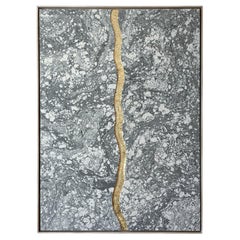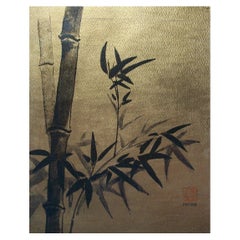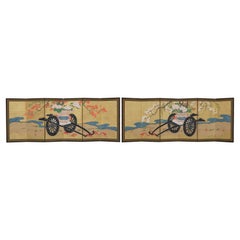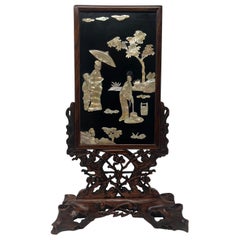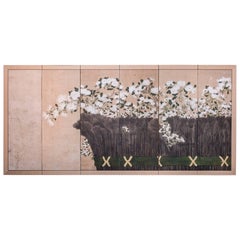Asian Paintings and Screens
to
274
927
315
1,485
103
9
41
26
16
4
4
2
2
1
161
603
721
112
287
147
68
36
4
30
13
5
16
19
19
7
2
709
672
612
518
425
1,597
1,426
923
448
132
1,597
1,556
1,570
29
4
3
3
2
Place of Origin: Asian
Vintage kimono textile art "Marble Story ~ Healing ~" by ikasu Grey, Japan
By Kimono ikasu
Located in Setagaya City, JP
This work uses a vintage kimono fabric with marble pattern, that makes it look like a real piece of marble.
The line in the middle symbolizes “kintsugi” - concept of wabi-sabi, which values imperfection, impermanence, and the beauty of aging.
It is elegantly framed with paulownia wood originally used for kimono chest-of-drawers, and is filled with storytelling and sense of luxury.
I used pieces of kimono that could no longer be used as clothing and kiritansu chest-of-drawers that would normally be discarded to create the ultimate upcycled piece.
<< Explanation and meaning of pattern and colors >>
Kintsugi (金継ぎ), which translates to "golden joinery" or "golden repair," is a traditional Japanese art form of repairing broken pottery with lacquer mixed with powdered gold, silver, or platinum. I used this tecnique here to "repair" antique kimono by transforming it into art work. Beyond its literal meaning of mending broken ceramics, kintsugi carries profound philosophical and cultural significance in Japanese tradition:
・Embracing Imperfection: Kintsugi celebrates imperfection and impermanence. Rather than disguising or concealing flaws, it highlights them, treating the breakage as part of the object's history. This philosophy encourages acceptance of imperfection as an essential aspect of life, beauty, and human experience.
・Wabi-Sabi Aesthetic: Kintsugi embodies the principles of wabi-sabi, an aesthetic worldview centered on the acceptance of transience and imperfection. Wabi-sabi values simplicity, authenticity, and the beauty of things that are imperfect, impermanent, and incomplete. Kintsugi exemplifies these principles by turning what might be considered flaws into features that enhance the object's beauty and character.
・Resilience and Transformation: The act of repairing broken things with precious metals symbolizes resilience and transformation. Instead of discarding or replacing the broken object, kintsugi honors its history and transforms it into something new and valuable. This reflects broader philosophical themes of overcoming adversity, finding beauty in imperfection, and embracing change.
・Honoring the Past: Kintsugi preserves and honors the history of the object. Rather than erasing or ignoring its past, it acknowledges and celebrates it. This aspect of kintsugi can be seen as a metaphor for honoring our own personal histories, including the challenges and setbacks we have faced, and recognizing how they have shaped us into who we are today.
・Spiritual and Philosophical Symbolism: Kintsugi has spiritual and philosophical implications, reflecting concepts such as the interconnectedness of all things, the cycle of life and death, and the pursuit of harmony and balance. The process of repairing broken objects with precious metals is seen as a metaphor for spiritual growth, enlightenment, and the journey towards wholeness.
Overall, kintsugi represents not only a practical technique for repairing ceramics but also a profound philosophical and cultural perspective on life, beauty, and the human experience. It embodies values such as resilience, acceptance, and the transformative power of embracing imperfection.
<< Characteristics of the fabric >>
This vintage textile is hand-painted with a traditional painting technique where the colors are added on wet surface, which creates an effect of marble.
<< About the frame >>
Kiritansu - chest-of-drawers for kimono, is traditionally made from paulownia wood, a uniquely Japanese material closely tied to the world of kimonos.
Paulownia wood is known as the lightest wood in Japan, prased for its natural luster, resistance to moisture, and resilience against cracking. Since ancient times, it has been used in crafting furniture, chests, and musical instruments.
During the Edo period, it became customary to store cherished kimonos in paulownia chests...
Category
1960s Japonisme Vintage Asian Paintings and Screens
Materials
Gold Leaf
MIEKO - Vintage Asian Style Painting on Paper - Signed - Japan - Late 20th C.
Located in Chatham, ON
MIEKO - Vintage Asian style painting on watercolor paper - signed with the artist's chop mark and name - Japan - late 20th century.
Excellent vintage condition - bleed through to th...
Category
Late 20th Century Anglo-Japanese Asian Paintings and Screens
Materials
Paint, Paper
Framed Korean Folk Painting of General Guan Gong
Located in Atlanta, GA
A Korean folk Shamanism watercolor on textile matted with woven brocade and presented in a wood frame with an oriental style metal hanging hardware. The painting was estimated to be from early 20th century circa 1910-1930s. It depicts Guan Yu (160-220AD), a legendary Chinese warrior and general from Eastern Han Dynasty. Long worshiped in China as a deity, across all three major religions, Guan Gong...
Category
Early 20th Century Folk Art Asian Paintings and Screens
Materials
Textile, Brocade
Pair of Japanese hinagata byôbu 雛形屏風 (small folding screens) with flower carts
Located in Amsterdam, NL
An amazing pair of six-panel hinagata byôbu (doll festival folding screens) with a continuous painting on gold leaf showcasing flower carts (hana’guruma) at the edge of a winding river.
Both laden with a large bamboo basket...
Category
Early 19th Century Antique Asian Paintings and Screens
Materials
Gold Leaf
Antique Chinese Carved Teak Wood and Mother Of Pearl Table Screen, Circa 1890.
Located in New Orleans, LA
Antique Chinese Carved Teak Wood and Mother Of Pearl Table Screen, Circa 1890.
Category
Late 19th Century Antique Asian Paintings and Screens
Materials
Teak, Mother-of-Pearl
Japanese Six-Panel Screen, Chrysanthemums and Twig Fence With Gold Flakes
Located in Hudson, NY
Rimpa School painting in mineral pigments with gofun and gold flakes on mulberry paper with a silk brocade border.
Category
19th Century Antique Asian Paintings and Screens
Materials
Gold
Chinese Geometric Lattice Door Panel, c. 1850
Located in Chicago, IL
A hallmark of Qing-dynasty domestic architecture, tall lattice panels such as this were used in traditional courtyard homes to allow light and air into a room whilst maintaining privacy. With grand proportions and an elongated window, this lattice door panel...
Category
Mid-19th Century Qing Antique Asian Paintings and Screens
Materials
Elm
Japanese Six Panel Screen, "Amorous Pheasants in Venerable Garden Pine"
Located in Hudson, NY
In a garden landscape with vibrant red camellias on a natural garden stone sculpture, mineral pigments and silver dust on mulberry paper.
Category
19th Century Antique Asian Paintings and Screens
Chinese Qing Reverse-Painted Mirror from the Qing Dynasty
By Chow's Oriental Furniture Co.
Located in Valladolid, ES
Stunning reverse-painted mirror from the 19th-century Qing Dynasty, depicting different scenes in a vertical narrative.
Different scenes with symbolic and auspicious elements frame r...
Category
1870s Qing Antique Asian Paintings and Screens
Materials
Crystal
Japanese Asian Edo Period Signed Framed Hand Painted Serpent Scroll Painting
Located in Studio City, CA
A beautiful and striking framed Japanese/ Asian serpent/snake scroll painting featuring two serpents/snakes in a garden landscape surrounded by blossoming ...
Category
18th Century Antique Asian Paintings and Screens
Materials
Wood, Paint, Paper
W.O.J. Nieuwenkamp (1874-1950) 'Wadah, Bali 1906’
Located in Amsterdam, NL
'Wadah, Bali 1906’
Signed upper right and with a pencil sketch annotated Boela(?), depot Stedelijk Museum Amsterdam and the artist’s stamp verso
Pen, brush and ink on paper laid do...
Category
Early 20th Century Asian Paintings and Screens
Materials
Paper
Japanese Screen Painting of Stallions
Located in Hudson, NY
Japanese two panel screen: Painting of stallions.
Kano school of painting.
Mineral pigments on mulberry paper.
Category
19th Century Antique Asian Paintings and Screens
Japanese Four Panel Screen: Dancing Figures
Located in Hudson, NY
People dressed in ceremonial robes and masks celebrate the New Year. On New Year's eve a traditional Japanese custom is to ward off evil spirits by pretending to chase away people w...
Category
20th Century Asian Paintings and Screens
Materials
Gold, Gold Leaf
Pair of Japanese Two Panel Screens Rabbits and Geese in Autumn
Located in Hudson, NY
Screen A: Autumn Scene with Geese in a Gentle Landscape. Lovely painting depicting geese under maple, in a gentle water landscape. Mineral pigments on paper with gold leaf clouds.
...
Category
Late 19th Century Antique Asian Paintings and Screens
Materials
Paint
Meiji Period Japanese Four Panel Screen Bijin At Leisure
Located in Hudson, NY
Japanese four panel screen: Bijin At Leisure. Ladies in a tea house with a small dog. Seal reads "Ensan dai" (drawn by Ensan). Meiji Period (1868 - 1912) pa...
Category
Late 19th Century Meiji Antique Asian Paintings and Screens
Materials
Silk, Wood
Japanese Two-Panel Screen: Ink Landscape on Silk
By Shunyu
Located in Hudson, NY
Japanese Two Panel Screen: Ink Landscape on Silk, Meiji period (1868 - 1912) painting of a man riding a mule on a pathway through the Kurotani mountains with a thatched roof shelter ...
Category
19th Century Meiji Antique Asian Paintings and Screens
Materials
Silk, Wood
W.O.J. Nieuwenkamp (1874-1950) 'Ida Bagoes Raki, Bali 1906’
Located in Amsterdam, NL
'Ida Bagoes Raki, Bali 1906’
Signed middle right, annotated at the bottom and with artist’s stamp verso
Pen, brush and ink on paper, H. 26.3 x W. 10.8 cm
Ida Bagoes Raki, here 22 y...
Category
Early 20th Century Asian Paintings and Screens
Materials
Paper
Japanese Six Panel Screen: Hawk with Ancient Pine Overlooking Twig Fence
Located in Hudson, NY
Beautiful and dramatic Kano school painting of a hawk perched on a rock. With flowering cherry, peonies, pine and bamboo. Twig fence on the right is made of heavily oxidized silver...
Category
18th Century Antique Asian Paintings and Screens
Materials
Gold Leaf, Silver Leaf
Japanese Six Panel Screen: Karako 'Chinese Children'
Located in Hudson, NY
Children at play in a Chinese palace garden, a favorite subject of Japanese painters. Kano School painting in mineral pigments on mulberry paper with si...
Category
18th Century Antique Asian Paintings and Screens
Materials
Bronze
Fine Chinese Export Reverse Painting on Glass
Located in San Francisco, CA
A well-executed Chinese export reverse painting on glass depicting an elaborate interior scene with many figures engaged in various domestic activities. This is a finely drawn compos...
Category
Late 19th Century Chinese Export Antique Asian Paintings and Screens
Materials
Glass, Paint
Japanese Two Panel Screen, Turkeys
Located in Hudson, NY
Mineral pigments on silk, mounted on a gold panel, in silk border. Signature and seal read: Yoho.
Category
Early 20th Century Asian Paintings and Screens
Materials
Silk
Fine Mughal Painting of a ‘Lion at Rest’, North India, Early 19th Century
Located in Amsterdam, NL
A Mughal painting of a ‘Lion at rest’
North India, early 19th century
?
Watercolour on paper, H. 46.5 x W. 68 cm
?The present painting is a large...
Category
Early 19th Century Antique Asian Paintings and Screens
Materials
Paper
Pair of Antique Carved Stone Panels, Japanese, Decorative, Figures, Victorian
Located in Hele, Devon, GB
This is a pair of antique carved stone panels. A Japanese, lacquered decorative scene with female figures, dating to the late Victorian period, circ...
Category
Late 19th Century Japonisme Antique Asian Paintings and Screens
Materials
Stone
Japanese Two Panel Screen: Painted Fans on Gold Leaf
Located in Hudson, NY
Mineral pigments on gold leaf with brocade border. Calligraphy and sketching on back paper.
Category
Late 19th Century Antique Asian Paintings and Screens
Materials
Gold Leaf
W.O.J. Nieuwenkamp (1874-1950) Statue of Vishnu Garuda, Bali, 1904
Located in Amsterdam, NL
Statue of Vishnu Garuda, Bali, 1904
Signed with initials
Pencil and ink on paper, 21.4 x 21.3 cm
Literature:
Bruce W. Carpenter, W.O.J. Nieuwenkamp. First European Artist in Bali, ...
Category
Early 20th Century Asian Paintings and Screens
Materials
Paper
W.O.J. Nieuwenkamp (1874-1950) Batur Temple and Batur Mountain before eruption
Located in Amsterdam, NL
Batur Temple and Batur Mountain before the eruption, Bali 1904
Signed, dated, and titled lower left and with artist's stamp verso
Pen, brush and ink on cardboard, H. 16.7 x W. 21.8...
Category
Early 20th Century Asian Paintings and Screens
Materials
Paper
Japanese 17th Century Two Panel Screen, Pine with Gold Dust
Located in Hudson, NY
Beautiful 17th century painting of pine trees. Painting in good condition on 19th century mounting. Mineral pigments and gold dust on mulberry paper w...
Category
17th Century Edo Antique Asian Paintings and Screens
Materials
Paper
Japanese Two Panel Screen: Mountain Landscape With Cedar and Pine on Gold Leaf
Located in Hudson, NY
Kano School painting, reminiscent of early Kano School paintings, in sumi (ink) and minimal pigments on gold leaf with a silk brocade border.
Category
Early 19th Century Antique Asian Paintings and Screens
Materials
Gold Leaf
Unpei Kameyama, 'a View of Black 'American' Ships in the Bay of Uraga Senminato'
Located in Amsterdam, NL
Unpei Kameyama (1821-1899)
A view of black (American) ships in the bay of Uraga Senminato, Miura district, June 1853
The Japanese text reads: ‘The seventy-six old men for the Kitamura-clan, drawn in 1897 on request of Yoshisada Kitamura, Himeji, the black ships which so much changed the fate of Japan, enjoy please this masterpiece by Harima Shonin Bisei who brings back memories of his young days.’
Watercolour on paper, laid down on cardboard, H. 44.5 x W. 115.5 cm
Provenance:
Collection of Yoshisada Kitamura, Himeji
Yoshisada Kitamura (1838-1899), the son of a farmer in the village of Ogawa, in the district of Harimakashikihigashi, studied under Matajiro Otaka and got heavily involved in the anti-Shogunate movement. He was active in several military incidents against the Shogunate. After the Meiji restoration, he served the Meiji government as a local official in the Himeji domain.
Kameyama Unpei was a Confucian scholar, a Shinto priest...
Category
Mid-19th Century Edo Antique Asian Paintings and Screens
Materials
Paper
Japanese Two-Panel Screen "Women in Western Dress"
Located in Hudson, NY
Japanese Two Panel Screen: Women in Western Dress, Nihonga style painting of two young women in Western style summer clothing, sitting at water's edge and cooling off by putting their feet in the water. Showa period painting...
Category
1930s Showa Vintage Asian Paintings and Screens
Materials
Wood, Paper
Japanese Landscape Painting, Hanging Scroll Painting
Located in Greenwich, CT
Japanese scroll painting of landscape painting depicted village along the riverside in the mountains with fisherman
Ink and color on silk
Overall size...
Category
19th Century Antique Asian Paintings and Screens
Materials
Silk
W.O.J. Nieuwenkamp (1874-1950) 'Stone statue in the temple at Madura, India'
Located in Amsterdam, NL
Stone statue in the temple at Madura, India, 1914
Signed with initials and dated, bottom left
Pencil on paper, 25.4 x 16.7 cm
Literature:
Ernst Braches en J.F. Heijbroek, W.O.J. ...
Category
Early 20th Century Asian Paintings and Screens
Materials
Paper
W.O.J. Nieuwenkamp (1874-1950) 'Part of the ring-wall of the Taj Mahal, India'
Located in Amsterdam, NL
Part of the ring-wall of the Taj Mahal, Agra, India, 1914
Signed with initials and dated bottom right
Black chalk on paper, 45.5 x 53 cm
Literature:
Ernst Braches en J.F. Heijbroek...
Category
Early 20th Century Asian Paintings and Screens
Materials
Paper
Japanese Two Panel Screen: Bamboo Grove on Mulberry Paper with Gold Dust
Located in Hudson, NY
Kano School painting of a bamboo grove with blooming flowers and gold dust mists. Painted in mineral pigments on mulberry paper with gold dust and a silk brocade border.
Category
Early 19th Century Antique Asian Paintings and Screens
Materials
Gold
Japanese Two-Panel Screen, Mother and Kitten with Chrysanthemums
Located in Hudson, NY
Delicate painting of garden chrysanthemums with a fine gold mist. A cat grooms herself while a kitten plays with a chrysanthemum. Mineral pigments...
Category
Mid-19th Century Antique Asian Paintings and Screens
Materials
Gold
17th Century Japanese Two-Panel Screen, Gibbons of Folklore
Located in Hudson, NY
Japanese two-panel screen: Gibbons of Folklore, Edo period (17th century) Kano School painting of gibbons in Japanese fables. The left panel represents a Japanese fable of a monkey a...
Category
Late 17th Century Edo Antique Asian Paintings and Screens
Materials
Silk, Wood, Paper
Japanese Two Panel Screen: Ikebana
Located in Hudson, NY
Beautifully painted basket arrangement of flowers in vivid color. Mineral pigments on applied silver and gold in a silk brocade border with black lacquer trim.
Category
Early 19th Century Antique Asian Paintings and Screens
Materials
Gold Leaf, Silver Leaf
B42 Japanese Antiques 6panels, Silver Paper, folding Screen, red-rimmed
Located in Niiza, JP
Silver foil folding screen
Material: Paper pasted on wooden frame
1 piece: Width 600 x Height 1745 x Depth 20 mm
Expanded size: Width 3640 mm
Folded size: Width 620 x Height 1745 x D...
Category
20th Century Asian Paintings and Screens
Materials
Paper
A Tibetan Prayer Book In Wooden Casing, 19th Century
Located in ARMADALE, VIC
A Tibetan Prayer Book in Wooden Casing, 19th Century
Aged leaves bound with leather strapping between hard covers.
Length: 53.5 cm Width: 13.5 cm...
Category
19th Century Antique Asian Paintings and Screens
Materials
Hardwood, Paper
$1,125 Sale Price
25% Off
1844 - Chichi, Japanese Scroll Painting. Colour on Silk
Located in Kyoto, JP
Mother’s Breast (Chichi) 1844
Hanging scroll. Ink, pigments and gofun on silk.
Inscription:
Kouka era, dragon year, late winter, painted by Shozan Yashou
Artist’ seals:
...
Category
1840s Edo Antique Asian Paintings and Screens
Materials
Silk
20th Century Silk Embroidery Chinese Decorative Panel, 1980s
Located in Vicoforte, Piedmont
Great late 20th century Chinese decorative panel. Artwork on silk and tissue, embroidered, colored and painted, depicting a landscape with fi...
Category
1980s Vintage Asian Paintings and Screens
Materials
Fabric
19th C. BALINESE ELEPHANT SCENIC-SCAPE Painting
Located in Hawthorne, CA
Listing Description – 19th-Century Balinese White Elephant Allegorical Painting, Color on Cloth with Gilt
An exquisite and richly symbolic 19th-century Balinese painting, rendered i...
Category
Mid-19th Century Other Antique Asian Paintings and Screens
Materials
Paint, Paper
Japanese Two Panel Screen: Pheasants in an Abstract Landscape
Located in Hudson, NY
Japanese Two Panel Screen: Pheasants in an Abstract Landscape. Taisho period (1912-1926) bold, almost graphic painting of pheasants and other bir...
Category
Early 20th Century Taisho Asian Paintings and Screens
Materials
Fabric, Wood
Tibetan Thangka of Amitabha Buddha Hand Painted Gilded
Located in Somis, CA
One of our finest hand painted Tibetan Thangkas from Nepal. This extraordinary Thangka depicts 108 Buddhas with consorts in celestial court witnessing Amitabha's achievement of nirva...
Category
2010s Asian Paintings and Screens
Materials
Gold Leaf
$1,125 Sale Price
50% Off
Fine Framed Japanese Painting of Samurais and Archers
Located in Greenwich, CT
refined Japanese brush painting of samurais and archers in the landscape, a section originally from a handscroll.
ink and color on silk. Cons...
Category
19th Century Antique Asian Paintings and Screens
Materials
Silk
Set of 6 Large Kakemonos Japanese Mythology, 19th Century Japan circa 1800 Edo
Located in Beuzevillette, FR
Beautiful set of 6 large kakemonos from 19th century Japanese mythology.
Paper support with a canvas pasted on the paper
Wonderful set that is part of Japan's history and beliefs
When not hung, the Kakemonos are rolled up.
circa 1800 - Japan - Edo Period
A kakemono translates as "object to hang". In Japan this refers to a painting or calligraphy, most often done on silk or paper framed in a scroll that was intended to be hung on walls or in public lighting. This particular form, which allows them to be in a roll, dates back to the Tang dynasty in China (this would be related to the copying and preservation of ancient Buddhist texts). A Kami is a deity or spirit worshipped in the Shinto religion. A Yokai is a spirit, ghost, demon, or strange apparition from the creatures of Japanese folklore.
Each of these kakemonos represents a unique story:
- A kami, a Japanese deity, is shown painting a rainbow. Indeed, he performs the action with his right hand while his left hand holds a kind of basket with three pots of paint. This kami has a rather closed attitude. He is standing in a dark and tormented sky. Below this figure, 8 villagers are dressed in traditional Japanese clothes. Their faces are softened. They are not afraid of the elements made by the kami above their heads.
- A character with an unreal look is holding a kind of jar with his two hands, which he spills on human figures above. This being is floating in the air, probably a character from mythology, perhaps Susanoo. Underneath, villagers on umbrellas. They are trying to protect themselves as best they can from what is falling on them. One of them is carrying baskets with fish on her shoulders. A character in the background is thrown forward and falls.
- On this kakemono, the god Raijin, dressed in a white and blue outfit, strikes the sky with his two drum hammers to create lightning and its thunderous sound. Surrounded by Tomoe and a long red scarf, Raijin, enraged and with dishevelled hair, creates a dark and violent storm. The villagers seem frightened by this meteorological phenomenon. One of the villagers can be seen fainting in the arms of a man. This scene may seem chaotic, but Japanese legend tells us that once a field is struck by lightning, the harvest is good.
- On this kakemono, we see an unreal-looking figure holding a fan, as if he were sweeping away the bad weather, or simply producing gusts of wind. He is probably the kami of wind and air, Shina tsu-hiko. The figures below him seem surprised by so much wind. An umbrella flies away on the left, the women hold their hair and scarf, the clothes are caught in the power of the wind, there is even a woman on the ground on the bottom left.
- This Kakemono represents a short moment. This Raiju is a yokai (ghost spirit...
Category
19th Century Edo Antique Asian Paintings and Screens
Materials
Paper
Japanese Two-Panel Screen, Ferns and Young Pine
Located in Hudson, NY
Delicately painted on mulberry paper, signature and seal read: Shiko. The artist, Sakakibara Shiko, (1895-1969) was born in Kyoto.
Measures: 28.5" H X 73.5" W
72.39 X 186.69 (in ...
Category
Early 20th Century Asian Paintings and Screens
Materials
Wood, Paper
Chinese Hanging Scroll of Prunus Branches, circa 1850
Located in Chicago, IL
Chinese scholars used natural imagery and scenery to aid in contemplation within the walls of their studios. The complex beauty inherent to landscapes and natural forms inspired clea...
Category
Mid-19th Century Qing Antique Asian Paintings and Screens
Materials
Paper
Japanese Single Panel Moon Landscape
Located in Hudson, NY
Lacquer painting on wood.
Category
Mid-20th Century Asian Paintings and Screens
Materials
Lacquer
Chi Shing, 'River Boats I', Framed Watercolor Painting, China, Mid-20th C
Located in Chatham, ON
CHI SHING - 'River Boats I' - Vintage watercolor landscape painting - vintage gold tone metal frame - finished with double matte boards - signed lower left -...
Category
Mid-20th Century Chinoiserie Asian Paintings and Screens
Materials
Metal
Multicolored Batik with Butterflies on frame. Central Java
Located in Antwerp, BE
Multicolored batik with butterflies and flowers on blue background, on frame.
Central Java, circa 1970. Signed Pandik.
Exquisite Batik Wall Decoration w...
Category
Mid-20th Century Hollywood Regency Asian Paintings and Screens
Materials
Textile, Wood
Natural Organic Burl Wood Flower Display Table, 38"
Located in South Burlington, VT
An attractive example of a burl wood natural organic wood flower or display table crafted from golden camphor wood root and burl. This stunning single roo...
Category
Late 20th Century Organic Modern Asian Paintings and Screens
Materials
Wood, Organic Material
Japanese Two Panel Screen: Gibbons in a Tree
Located in Hudson, NY
Ink painting on mulberry paper of gibbons in a tree with hints of gold in the sky.
Category
Early 18th Century Antique Asian Paintings and Screens
Materials
Paper
Japanese Two-Panel Screen, Young Pine in Snow
Located in Hudson, NY
Beautifully painted by Kido So (1899 - 1984). Born in Kyoto So studied painting at the Kyoto Municipal School of Painting under Yamamoto Shunkyo (1871...
Category
1930s Vintage Asian Paintings and Screens
Materials
Silk
W.O.J. Nieuwenkamp (1874-1950) 'Four outrigger proa’s on the beach of Kusambe'
Located in Amsterdam, NL
Four outrigger proa’s on the beach of Kusambe, Bali, 1937
Signed with initials, dated and described with location bottom left
Pencil and ink on paper, 29.7 x 35 cm
Category
Early 20th Century Asian Paintings and Screens
Materials
Paper
Reverse Glass Painting of Shiva, Parvati and Ganesh from the Pal Collection
Located in Dallas, TX
PRESENTING a STUNNING and HIGHLY DESIRABLE and IMPORTANT 19C Reverse Glass Painting of Shiva, Parvati and Ganesh from the Pal Collection.
This piece has impeccable Provenance!
It was purchased by a Private Dallas Collector at Christie’s New York Auction on 20th March 2008. Sale Number 2112, Lot No. 290.
Christie’s operate a twice yearly auction of Southeast Asian Art & Antiquities in New York in the months of March and September.
This sale was titled “The Scholar’s Vision: The Pal Family Collection”.
The painting was described as “A reverse glass painting of Shiva, Parvati and Ganesh – India, Maharashtra, 19th Century.
The holy family seated on the floor, mother and child in the lap of Shiva, with a red background and blue borders. Opaque pigments and metal leaf on glass. 12 x 16 in. (30.4 x 40.6 cm.)
Exhibited:
Durga: Avenging Goddess, Nurturing Mother, Norton Simon Museum of Art, 7 October 2005 – 27 March 2006″.
It carried an Auction estimate of USD 2,500 to USD 3,500 and Sold for USD 2,500 (not including Buyers Premium).
Allowing for inflation alone this would be over $4,300 in today’s value. At highest estimate, this would equate to over $6k in today’s value.
As an added bonus and proof of authenticity the painting still retains it’s original Christie’s Lot No. Label.
It has substantially increased in value over the years as a RARE piece from the ‘renowned’ Pal Family Collection and a RARE piece of antique Asian Indian...
Category
Mid-19th Century Anglo-Indian Antique Asian Paintings and Screens
Materials
Glass
Japanese Two-Panel Screen Dog Resting Beside a Thorny Hedge
Located in Hudson, NY
Japanese two-panel screen: Dog Resting Beside a Thorny Hedge, Showa period (1926 - 1989) painting of a white dog through an exaggerated thorny ...
Category
Mid-20th Century Showa Asian Paintings and Screens
Materials
Wood, Paper
Japanese Two Panel Screen Peonies In the Mist
Located in Hudson, NY
Japanese Two Panel Screen: Peonies In the Mist. Showa period (1926 - 1945) painting in oil on canvas of peonies with gold and silver dust clouds. Signature reads, Seishu.
Category
1930s Showa Vintage Asian Paintings and Screens
Materials
Gold Leaf, Silver Leaf
Large Mixed Media of 5 Ceremonial Deity Masks Wall Hanging
Located in Miami, FL
A generously sized decorative Chinese framed mixed media depiction of 5 ceremonial deity masks, 20th Century. This large wall hanging mixed media of ceremon...
Category
20th Century Asian Paintings and Screens
Materials
Paint, Paper
$800 Sale Price
66% Off
Japanese Two Panel Screen Mountain Landscape on Gold Silk
Located in Hudson, NY
Nanga School; by female artist Kia Kozan. Showa Period (1926-1989) Translation: Kai Kozan 1867-1961, from Bungo area in Kyushu. Graduated from Bunchu-en Girls School. Signature and s...
Category
Mid-20th Century Asian Paintings and Screens
Materials
Paper
Recently Viewed
View AllMore Ways To Browse
Japanese Red Lacquer Frame
Lattice Panel Wood
Hanging Japanese Screen
Japanese Lattice
Japanese 19th Century Meiji Period Silk Painting
Japanese Buddhist Screen
Japanese Carved Screen
Japanese Screens And Doors
Monkey Screen
Japanese Autumn Screen
Japanese Screens Six Fold
Japanese Wood Room Divider
Kyoto Silk Painting
Japanese Dragon Painting
Japanese Birds Painted On Silk
Heian Period
Japanese Crane Panel
Japanese Divider Screen
